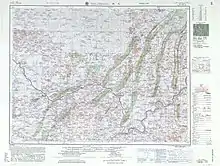Neijiang
Neijiang (simplified Chinese: 内江; traditional Chinese: 內江; Sichuanese Pinyin: Nui4jiang1; Sichuanese pronunciation: [nuei˨˩˧tɕiaŋ˥]; pinyin: Nèijiāng; Wade–Giles: Nei-chiang) is a prefecture-level city in the southeast of Sichuan province, People's Republic of China. It is located on the Tuo River and is a transportation and food-processing center. The population of the entire prefecture was 3,702,847 at the 2010 census, and the population of the built-up (metro) area was 1,251,095 in the 2 urban districts of Shizhong and Dongxing.
Neijiang
内江市 Nei-chiang, Neikiang | |
|---|---|
 Neijiang in 2012 | |
 Location of Neijiang in Sichuan | |
| Coordinates (Neijiang municipal government): 29°34′49″N 105°03′29″E | |
| Country | People's Republic of China |
| Province | Sichuan |
| Municipal seat | Shizhong District |
| Area | |
| • Prefecture-level city | 5,385.33 km2 (2,079.29 sq mi) |
| • Urban | 1,568.1 km2 (605.4 sq mi) |
| • Metro | 1,568.1 km2 (605.4 sq mi) |
| Population (2010 census[1]) | |
| • Prefecture-level city | 3,702,847 |
| • Density | 690/km2 (1,800/sq mi) |
| • Urban | 1,251,095 |
| • Urban density | 800/km2 (2,100/sq mi) |
| • Metro | 1,251,095 |
| • Metro density | 800/km2 (2,100/sq mi) |
| Time zone | UTC+8 (China Standard) |
| Postal code | 641000 |
| ISO 3166 code | CN-SC-10 |
| Website | www |
History

In medieval times the locality was an important salt-producing area, but in recent times its name has been associated with the cultivation of sugarcane; it is commonly referred to as the sugar capital of Sichuan. During the economic boom of China in the 1990s and early 21st century, Neijiang has been transformed and its industries now range from engineering, electronics, chemicals, construction materials, to consumer goods. It is also the home of Neijiang Normal College and many other educational institutions. Its geographic location puts it in the center of the southern Sichuan transport network. Neijiang is also the hometown of Zhang Daqian, one of the best-known and most prodigious Chinese artists of the twentieth century.
Administrative divisions
| Map | ||||||
|---|---|---|---|---|---|---|
| # | Name | Hanzi | Hanyu Pinyin | Population (2010) |
Area (km²) | Density (/km²) |
| 1 | Shizhong District | 市中区 | Shìzhōng Qū | 501,285 | 388 | 1,292 |
| 2 | Dongxing District | 东兴区 | Dōngxīng Qū | 749,810 | 1,181 | 635 |
| 3 | Longchang City | 隆昌市 | Lóngchāng Shì | 633,210 | 794 | 797 |
| 4 | Weiyuan County | 威远县 | Wēiyuǎn Xiàn | 626,482 | 1,289 | 486 |
| 5 | Zizhong County | 资中县 | Zīzhōng Xiàn | 1,192,060 | 1,734 | 687 |
Climate
| Climate data for Neijiang (Dongxing District, 1981−2010 normals) | |||||||||||||
|---|---|---|---|---|---|---|---|---|---|---|---|---|---|
| Month | Jan | Feb | Mar | Apr | May | Jun | Jul | Aug | Sep | Oct | Nov | Dec | Year |
| Record high °C (°F) | 17.6 (63.7) |
23.9 (75.0) |
31.9 (89.4) |
34.6 (94.3) |
36.6 (97.9) |
38.0 (100.4) |
38.8 (101.8) |
40.4 (104.7) |
39.1 (102.4) |
32.4 (90.3) |
25.0 (77.0) |
17.8 (64.0) |
40.4 (104.7) |
| Average high °C (°F) | 9.9 (49.8) |
13.6 (56.5) |
18.6 (65.5) |
23.3 (73.9) |
27.3 (81.1) |
28.5 (83.3) |
32.0 (89.6) |
31.1 (88.0) |
27.6 (81.7) |
21.4 (70.5) |
16.7 (62.1) |
11.2 (52.2) |
21.8 (71.2) |
| Daily mean °C (°F) | 6.9 (44.4) |
9.8 (49.6) |
13.8 (56.8) |
18.2 (64.8) |
22.1 (71.8) |
24.1 (75.4) |
27.0 (80.6) |
26.2 (79.2) |
23.2 (73.8) |
18.0 (64.4) |
13.2 (55.8) |
8.3 (46.9) |
17.6 (63.6) |
| Average low °C (°F) | 4.7 (40.5) |
7.2 (45.0) |
10.4 (50.7) |
14.6 (58.3) |
18.3 (64.9) |
21.0 (69.8) |
23.5 (74.3) |
22.9 (73.2) |
20.2 (68.4) |
15.8 (60.4) |
11.0 (51.8) |
6.3 (43.3) |
14.7 (58.4) |
| Record low °C (°F) | −1.7 (28.9) |
−0.8 (30.6) |
1.4 (34.5) |
5.9 (42.6) |
11.1 (52.0) |
15.6 (60.1) |
17.4 (63.3) |
16.8 (62.2) |
14.6 (58.3) |
8.5 (47.3) |
0.8 (33.4) |
−2.4 (27.7) |
−2.4 (27.7) |
| Average relative humidity (%) | 86 | 80 | 76 | 77 | 76 | 84 | 83 | 83 | 85 | 89 | 87 | 86 | 83 |
| Source: China Meteorological Data Service Center[2] | |||||||||||||
Transportation
Neijiang railway station is situated on the Chengdu–Chongqing railway and is the most central. The Neijiang–Kunming railway also starts here. Neijiang North railway station is situated on the Chengdu–Chongqing intercity railway and is served by high-speed trains.
References
- http://www.citypopulation.de/php/china-sichuan-admin.php
- 中国地面气候标准值月值(1981-2010) (in Chinese). China Meteorological Data Service Center. Retrieved 20 October 2018.
